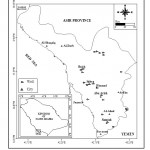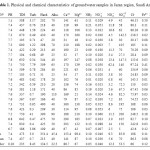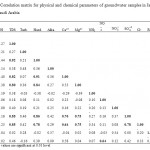Groundwater Quality Assessment in Jazan Region, Saudi Arabia
Adel M. Alhababy1,2 * and Abdul Jabbar Al-Rajab3
1
Center for Environmental Research and Studies,
Jazan University,
Jazan,
Saudi Arabia
DOI: http://dx.doi.org/10.12944/CWE.10.1.03
Copy the following to cite this article:
Alhababy A. M, Al-Rajab A. J. Groundwater Quality Assessment in Jazan Region, Saudi Arabia. Curr World Environ 2015;10(1) DOI:http://dx.doi.org/10.12944/CWE.10.1.03
Copy the following to cite this URL:
Alhababy A. M, Al-Rajab A. J. Groundwater Quality Assessment in Jazan Region, Saudi Arabia. Curr World Environ 2015;10(1). Available from: http://www.cwejournal.org/?p=8535
Download article (pdf)
Citation Manager
Publish History
Select type of program for download
| Endnote EndNote format (Mac & Win) | |
| Reference Manager Ris format (Win only) | |
| Procite Ris format (Win only) | |
| Medlars Format | |
| RefWorks Format RefWorks format (Mac & Win) | |
| BibTex Format BibTex format (Mac & Win) |
Article Publishing History
| Received: | 2015-02-07 |
|---|---|
| Accepted: | 2015-02-22 |
Groundwater is the sole resource of drinking water in arid areas, which is also used in domestic consumption and irrigation1, 2. Information about groundwater occurrence and recovery is critical in the arid and semi-arid areas because of the poor yearly precipitations rate and over use of groundwater resources in these areas3,4. On the other hand, groundwater quality is dominant to use it as drinking water or in domestic uses and irrigations; its quality depends on different factors such as recharged water quality, rainfall, geochemical processes, and human activities5. Water pollution affects simultaneously the water quality and threats the economic development and social prosperity by affecting the human health6,7. Physico-chemical properties of groundwater are being the key tool to estimate the water quality and its suitability for drinking, irrigation, or domestic uses8, 9. Groundwater is an important source of acceptable water for drinking in the arid regions and in particular in the Saudi Arabia where it is the sole water source for drinking, also used in irrigation. Jazan is the smallest province in Saudi Arabia covers an area of 13500 km2 in southwestern part of Saudi Arabia as a part of Tihama plain (Fig. 1), with a population of 1.5 million inhabitants10. The climate of Jazan is arid, hot and windy with a high humidity rate influenced by the Red Sea, the annual mean temperature 28°C, relative humidity 62%, and annual precipitation of 62 mm (Saudi presidency of meteorology and environment, unpublished data).
Demand on groundwater is increasing in Saudi Arabia due to the population growth and significant economic advancement. Fresh water supply is an important issue worldwide, about 90% of fresh water in the world originated from groundwater11. Water resources assessment represents a major concern of the present world due to the importance of water for human being and society and for implementing sustainable water-use strategies12. Moreover, information about water quality analysis is always used as a basis to discuss utilizing groundwater in order to avoid associated water illnesses and health problems13. Groundwater quality depends, to some extents, on its chemical composition. Cations and anions play important roles as indicators of groundwater contamination14,15,16. Hussain et al.3 reported the contamination of groundwater of central Rajastan in India with Fluoride, as consequence, most individuals in the contaminated region suffer from mild and moderate fluorosis.
Information on the assessment of groundwater quality is particularly scarce in Jazan. Within this context, the aims of this work were, to assess the groundwater quality in public wells in Jazan area, and to compare the results with the different standards. Results of this study will be helpful for the decision makers in determining appropriate actions and using integrated water resources management tools to protect groundwater from the possible contamination, also to establish a scheme of sustainable groundwater development in the area. To the best of our knowledge, this is the first work in Jazan area on the assessment of groundwater quality.
Materials and Methods
Samples from twenty three groundwater public wells were collected during fall 2014 from different location in Jazan province (Fig. 1). All investigated wells belong to the General Directorate of Water in Jazan. 5L of water were collected from each well in an amber plastic container (Naizak, KSA) washed previously with distilled water. Then, a sub-sample of 100 mL transferred into a 250 mL Erlenmeyer flask (Alkamal, KSA) to measure the physical properties such as the Total Dissolved Solids (TDS) and pH directly after sampling using the Multimeter 340/I (WTW) (GeoTech, USA). For each sample, a sub-sample of 20 mL transferred into a 20 mL PE flask for analysis of anions, and another sub-sample was filtered and filled into 20 ml PE flasks for analysis of cations, then some drops of pure HNO3 were added to the sub-sample for conservation.
 |
Fig.1: Location map showing groundwater sampling wells in Jazan province. Click here to View figure |
Samples collected from all wells were identified and transferred to lab refrigerated at 4°C in an ice-chest cooler, then stored in fridge at 4°C in the analytical laboratory of General Directorate of Water (Jazan) till analysis within 2 days.
Analytical Procedures
Collected water samples were analyzed in laboratory for Turbidity, Hardness, Alkalinity, Calcium (Ca2+), Magnesium (Mg2+), Ammonia (NH3), Nitrite (NO ), Nitrate (NO ) Sulfate (SO ), Chlorine (Cl-), Iron (Fe2+) and Fluoride (F-). Turbidity was determined by 2100Q Portable Turbidimeter (Hach, USA). Hardness, chlorine and Alkalinity were determined by EDTA titrimetric method. Calcium (Ca2+), Magnesium (Mg2+), Ammonia (NH3), Nitrite (NO ), Nitrate (NO ), Sulfate (SO ), Chlorine (Cl-), Iron (Fe2+) and Fluoride (F-) were determined by DR 5000 UV-Vis Spectrophotometer (Hach, USA). The statistical analysis of data was completed using Microsoft Excel software (version 2010, Microsoft Saudi Arabia) and SPSS (IBM, Germany), Groundwater quality was assessed using data of its physical and chemical properties compared with the standards of drinking water published by World Health Organization WHO17 and Gulf Standardization Organization GSO18.
Results and Discussion Groundwater General Parameters
The physico-chemical parameters of investigated samples are shown in Table 1. pH values in the investigated water samples ranged from 6.70 to 7.70 (mean, 7. 41) which characterized the groundwater of the investigated area by neutral. The pH values in all water samples in this study were within the safe limits of 8 WHO17. This result is in accord with Owamah et al.19 who reported pH values of groundwater samples collected from Niger Delta region lower than 8. TDS values in the collected samples ranged from 104 to 930 mg/l (mean 473.04 mg/l). The TDS values in all samples were below the WHO and GSO permissible limit of 1000 mg/l WHO17, and conform to results obtained by Anwar and Aggarwal22. The hardness of water samples in this study varied from 47.00 to 490.00 mg/l with a mean value of 251.39 mg/l. WHO17 mentioned that water samples which have hardness values more than 200 mg/l could cause serious problems to the distribution system, pipes and tanks, in addition to increase the soap consumption. The concentration of ammonia (NH3) varied from 0.01to 0.21mg/l with a mean value of 0.10 mg/l, this value is significantly below the limit of 1.5 mg/l WHO17. Nitrite (NO ) concentrations in collected water samples were ranged from 0.00 to 0.19 mg/l with a mean value of 0.04 mg/l, this value is significantly below the admissible limit of 3 mg/l WHO17.
Cations Concentrations
Some cations are usually present at high concentrations (>1 mg/l) in groundwater such as magnesium, calcium, potassium, and sodium20. Table (1) shows the concentrations of different cations measured in the groundwater samples of this study.
 |
Table1: Physical and chemical characteristics of groundwater samples in Jazan region, Saudi Arabia. Click here to View table |
Concentrations of magnesium and calcium in water samples were varied from 31.00 to 360 and 16.00 to 260.00 mg/l, the mean values were respectively 153.35 and 98.39 mg/l. In general, the concentration of magnesium in groundwater is less than the concentration of calcium due to their relative abundance the surrounding rocks21, 4. Concentrations of calcium (Ca2+) and magnesium (Mg2+) in groundwater samples were significantly higher in the wells located in the west of Jazan province (wells No: 9, 11, 18, 21 and 22; table 1) than in other areas due to the rain flow direction from east to west in the mountainous areas of Jazan region.
Anions Concentrations
Some anions are usually present at high concentrations (>1 mg/l) in groundwater such as chloride, sulfate, and bicarbonate20, 22. Table (1) shows the concentrations of different anions measured in the groundwater samples of this study. The concentrations of chloride were lows in all groundwater samples, whereas the contents of sulfate were high. Dissolving of sodium chloride in water from surrounding soils and rocks produces chloride. Usually, sodium chloride has no effect on suitability of water for drinking except if it was present at high concentration which can make water corrosive or unpotable. The chloride concentrations ranged from 24.85 to 248.50 mg/l (mean, 107.99), this value is below the admissible limit of 250 mg/l WHO17. These results are in accord with data reported by Oiste12. In general, the sulfate presents in groundwater as sodium, magnesium, and calcium soluble salts. Sulfate concentration changes with time significantly during the recharge of groundwater and infiltration of rainfall4. The concentrations of sulfate in the collected samples varied from 5.00 to 200.00 mg/l (mean, 85.87 mg/l), this value is below the admissible limit of 500 mg/l WHO17 and GSO18. The nitrate concentrations ranged from 0.80 to 62.40 mg/l (mean, 9.31 mg/l), its concentration was acceptable in all samples (<50 mg/l; WHO17) except in the water of one well (No 10, table 1) with a high value of 62.4 mg/l. The high concentration of nitrate in this location might be due either to a leak in the sewage tanks around the well (absence of complete pipes sewage system in this area), or contamination by chemical fertilizers contain nitrogen. Wastewater represents one of the most important sources of contamination of groundwater with nitrate, especially when sewerage system is not available2, 23. Pollution of groundwater with nitrate is a worldwide problem, which could increase health risk at high concentrations and consequently limit the water supply24. In the drinking water, the nitrate concentration >50 mg/l has some health effects on people with kidneys problems and especially on infants causing the blue baby syndrome and gastric carcinoma4, 21, 25. Iron concentrations (Fe2+) ranged from 0.01 to 0.50 mg/l (mean, 0.11 mg/l), its concentration was acceptable in all samples (<50 mg/l; WHO17). Fluoride (F-) is inorganic element present in the subsurface depending on the geology of the region. In this study, chemical analysis showed no significant difference for fluoride concentration in all samples. Fluoride concentrations varied from 0 to 1.30 mg/l (average of 0.31 mg/l) which is below the maximum recommended concentration of 1.5 mg/l (WHO17). This result conforms to other results reported by Jain et al.4 and Kim et al.2.
Correlation Analysis
The correlation analysis of the measured parameters was realized and the correlation coefficients presented in Table (2). TDS and hardness showed significant positive correlations with SO , Cl−, Mg2+, and Ca2+, and among themselves. Otherwise, the correlation between TDS and hardness was high, which could be due to the depending of hardness on the TDS in water6, 4. On the other hand, fluoride was significantly correlated only to nitrite (Table 2). Calcium and magnesium were positively and significantly correlated with Cl− and SO . Furthermore, SO was correlated significantly and positively with Cl−.
 |
Table2: Correlation matrix for physical and chemical parameters of groundwater samples in Jazan region, Saudi Arabia. Click here to View table |
Conclusion
Groundwater represents the sole source of drinking water supply in Jazan region, Saudi Arabia. The absence of a complete piped sewage system and the relatively high agricultural activities in this area might present a potential risk of contamination of groundwater. In the present work 23 wells representing Jazan area were selected to define their suitability as drinking water resources in fall 2014. Our results showed that groundwater of all investigated wells were considered suitable for drinking and domestic uses based on the comparison of our results with the standards of the WHO and GSO. However, the concentration of nitrate was above the acceptable limit of 50 mg/l in only one well (No 10) which should be avoided as drinking water resource, and might be used safely in irrigation. On the other hand, the concerned authorities are invited to ensure a regular investigation regarding the groundwater quality in Jazan area. Water supplies and sanitation are crucial to the water sustainability development of Jazan region, and a special attention should be paid to the concentration of TDS and nitrate in groundwater in future studies.
Acknowledgements
Authors would thank the General Directorate of Water in Jazan and especially Fahd Akeel the head of analytical laboratory for his assistance during this work.
References
- Switzman, H.P. Coulibaly, and Z. Adeel, “Modeling the impacts of dryland agricultural reclamation on groundwater resources in Northern Egypt using sparse data.” Journal of Hydrology 520: 420–438 (2015).
- Kim, K-H., S-T. Yun, B. Mayer, J-H. Lee, T-S. Kim, H-K. Kim, “Quantification of nitrate sources in groundwater using hydrochemical and dual isotopic data combined with a Bayesian mixing model.” Agriculture, Ecosystems and Environment 199: 369–381 (2015).
- Hussain, J., I. Husain, and M. Arif, “Fluoride contamination in groundwater of central Rajasthan, India and its toxicity in rural habitants.” Toxicological and Environmental Chemistry 95 (6): 10481055 (2013).
- Jain, C. K., A. Bandyopadhyay, and A. Bhadra, “Assessment of ground water quality for drinking purpose, District Nainital, Uttarakhand, India.” Environmental Monitoring and Assessment 166 : 663–676 (2010).
- Vasanthavigar, M., K. Srinivasamoorthy, K. Vijayaragavan, R.R. Ganthi , S. Chidambaram, P. Anandhan, and S. Vasudevan, “Application of water quality index for groundwater quality assessment: Thirumanimuttar sub-basin, Tamilnadu, India.” Environmental Monitoring and Assessment 171(1-4): 595-609 (2010).
- Milovanovic, M., “Water quality assessment and determination of pollution sources along the Axios/Vardar River, Southeastern Europe.” Desalination 213 : 159–173 (2007).
- Al-Rajab A.J., and O. Hakami, “Bahavior of the non-selective herbicide glyphosate in agricultural soil. ” American Journal of Environmental Science 10(2): 94-101 (2014).
- Subba, R.N., “Seasonal variation of groundwater quality in a part of Guntur District, Andhra Pradesh, India.” Environmental Geology 49: 413–429 (2006).
- Edmunds, W.M., J.J. Carrillo-Rivera, and A. Cardona, “Geochemical evolution of groundwater beneath Mexico City.” Journal of Hydrology 258 : 1–24 (2002).
- Department of Statistics and Information, KSA. 2010. Population census preliminary results. )http://www.cdsi.gov.sa/( accessed on December 21st, 2014.
- Armon, R., and J. Kitty, The Health Dimension of Groundwater Contamination. In: Groundwater Contamination and Control, Holler (Ed.). Marcel Dekker, Inc., New York, USA (1994).
- Oiste, A.M., “Groundwater quality assessment in urban environment.” International Journal of Environmental Science and Technology 11:2095–2102 (2014).
- Nagarajan, R., N. Rajmohan, U. Mahendran, and S. Senthamilkumar, “Evaluation of groundwater quality and its suitability for drinking and agriculture use in Thanjavur city, Tamil nadu, India.” Environmental Monitoring and Assessment 171: 289-308 (2010).
- Chgue'-Goff, C., M.R. Rosen, and P. Eser, “Sewage effluent discharge and geothermal input in natural wetland, Tongariro Delta, New Zealand.” Ecological Engineering 12: 149 – 170 (1999).
- Sultan, M. E., “Characterization, classification, and evaluation of some ground water samples in upper Egypt.” Chemosphere 37(4): 735-745 (1998).
- Mattiesen, H., “Detailed chemical analyses of groundwater as a tool for monitoring urban archaeological deposits: results from Bryggen in Gergen.” Journal of Archaeological Science 35: 1378–1388 (2008).
- WHO (World Health Organization). Guidelines for drinking-water quality, fourth edition. 564 pages. ISBN: 9789241548151 (2011).
- GSO (Gulf Standardization Organization). GSO5/FDS/1025, 22 pages (2008).
- Owamah, I.H., A.K. Asiagwu, S.H.O. Egboh, and S. PhilUsiayo., “Drinking water quality at Isoko North communities of the Niger Delta Region, Nigeria.” Toxicological and Environmental Chemistry 95 (7):11161128 (2013).
- Younger, Paul L., Groundwater in the environment: An introduction. Blackwell Publishing, Oxford, UK & Malden, Massachusetts, 318 pp. ISBN 1-4051-2143-2 (2007).
- Singh, Vinod K., D.S. Bikundia, A. Sarswat, and D. Mohan, “Groundwater quality assessment in the village of Lutfullapur Nawada, Loni, District Ghaziabad, Uttar Pradesh, India.” Environmental Monitoring and Assessment 184(7): 4473-4488 (2012).
- Anwar K.M. and V. Aggarwal, “Analysis of Groundwater Quality of Aligarh City, (India): Using Water Quality Index.” Curr. World Environ., Vol. 9(3), 851-857 (2014).
- Al-Ariqi, W., and J. Abduljalil, “Assessment of hydrochemical quality of ground water under some urban areas within Sana'a secretariat.” Eclética Química 35(1): 77-84 (2010).
- Hernández-Espriú. A., E. Domínguez-Mariani, J. Reyna-Gutiérrez, P. Martínez-Santos, E. Sánchez-León, and L. Marín, “Nitrate mass balance in agricultural areas of intensive fertilizer.” Boletín de la Sociedad Geológica Mexicana 65(1): 39-50 (2013).
- Tank, D.K., and C.P.S. Chandel, “A hydrochemical elucidation of the groundwater composition under domestic and irrigated land in Jaipur City.” Environmental Monitoring and Assessment 166: 69–77 (2010).






